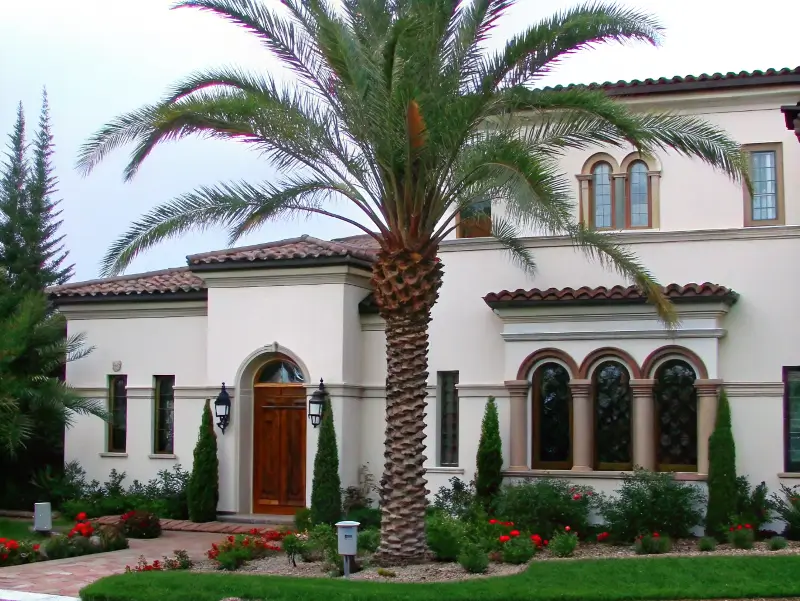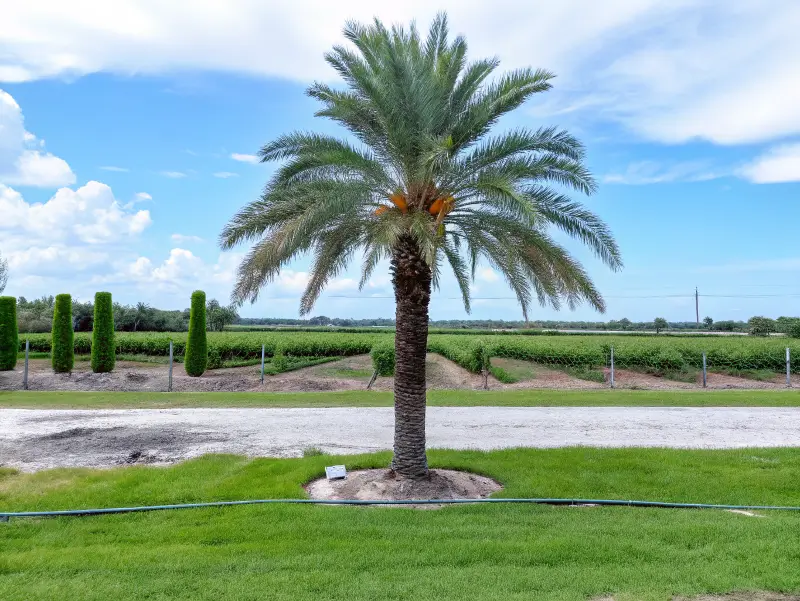
Curious about the sylvester palm tree and how it can liven up your yard? Stick around. Sooner or later, we all want to discover what makes one palm stand out from the rest. I’ve admired palms for ages and can’t wait to share a few insights I’ve picked up along the way.
In this article, we’ll chat about everything from basic traits to easy maintenance tips. You’ll also get cool landscape ideas and find answers to the most-asked questions about these tropical beauties. Grab your favorite cold drink, turn on some music, and let’s hop into this laid-back talk!
Table of Contents
Introduction to Sylvester Palm Trees
What Makes the Sylvester Palm Special?
I’ve always admired how palm trees add a tropical flair to any yard. The sylvester palm tree is no exception—its vibrant fronds, sturdy trunk, and chill vibe make it a fantastic choice if you want to brighten your outdoor space.
- Often called Phoenix sylvestris or silver date palm
- Known for being a hardy palm tree with strong adaptability
- Delivers a low-maintenance palm experience, perfect for busy folks
I love how this sylvester palm tolerates different climates. It doesn’t whine about intense sun or slightly cooler temperatures. That alone makes it a real buddy in my garden.
Additionally, the diamond cut sylvester palm trunk style is gorgeous. Nothing beats the neat, geometric pattern it adds to any landscape. I personally adore how each trimmed base forms a repeating diamond shape, giving it a polished look.
A Brief History and Origin of Phoenix Sylvestris
The sylvester palm trees trace back to parts of Asia, yet they’ve gained major popularity in the United States. They closely resemble classic date palms but are grown mostly for ornamental purposes. Some folks even call them “silver date palms” because of their grayish fronds.
- Belong to the same group as commercial date palms
- Known for the royal palm appearance but smaller fruit
- Perfect if you desire that exotic landscaping vibe without heavy upkeep
Over time, gardeners have embraced the sylvester palm diamond cut trunk, thanks to its sleek aesthetic.
Identifying Key Features of the Sylvester Palm
Physical Characteristics and Unique Appearance
Check out the captivating sylvester palm tree diamond cut trunk—it’s downright eye candy! I love how the fronds have a silvery-green sheen, giving the tree a modern spin. Plus, the diamond cut sylvester palm makes the trunk look extra regal and tidy.
- Palm fronds often appear silvery-green
- Trunk can be trimmed into geometric patterns
- Sylvester palm tree growth rate is moderate
This moderate growth is a plus in my eyes since you won’t wake up to a monster tree overshadowing everything. The average height might land around 40 feet if you give it prime conditions, though many remain a bit shorter. It’s also different from a royal palm appearance because it keeps a more uniform, manageable shape.
Seasonal Growth Patterns and Leaf Structure
Every palm has its own quirks. The sylvester palm tree holds a dense crown of fronds at the top, forming an attractive silhouette. Because of that, you’ll see it used as a focal point landscaping element that effortlessly sets the mood for a tropical staycation.
- Dense, symmetric canopy
- Gracious to breezes and mild storms thanks to stiff, palmate leaves
- Grows new fronds steadily during spring and summer
Meanwhile, older fronds at the bottom gradually brown, which is normal. If you love a tidy look, just trim them off. This regular grooming keeps everything shipshape.
I’ve personally found that steady care—like removing older leaves and giving appropriate water—helps it maintain a strong presence year-round. And honestly, I think it looks especially sweet during those warm months when new fronds burst forth, showing off that subtle silvery color.
Planting and Growing Conditions for Sylvester Palm Trees

Ideal Soil, Sunlight, and Climate Requirements
So you’ve decided on a diamond cut sylvester palm. Now it’s time for a decent planting spot. I like to place mine in full sun. Although partial shade won’t wreck it, direct sunlight for six to eight hours usually helps it thrive.
- Prefers well-draining soil
- Tolerates slight variations in climate
- Cold-hardy palm tree for mild freezes
For soil, anything rich and well-draining is great. If you live in a spot with heavy clay or poor drainage, toss in some sand or organic matter. It’s a drought-tolerant palm once established, but newly planted ones need a bit more reliable watering.
Since they’re somewhat cold-hardy, moderate dips in temperature rarely cause immediate trouble. That said, if a strong freeze is predicted, you might want to protect its trunk and fronds. The sylvester palm adapts to multiple zones, which is awesome if your climate swings from warm summers to slightly chilly winters.
Watering and Fertilization Guidelines
I’ll be real: overwatering is easy to do if you’re not careful. The sylvester palm trees appreciate a thorough drink every week or so, especially in hotter states. But guess what? They actually like a drying-out phase in between waterings.
- Water once a week in normal conditions
- Slight increase in summer if scorching hot
- Use a slow-release palm fertilizer
- Stick to a palm fertilization schedule in spring and summer
A balanced palm fertilizer can keep those leaves lush. If you notice fading or yellowing fronds, try adding a specialized palm mix with magnesium or potassium. Also, mulching around the base helps retain moisture and cuts down on pesky weeds. Make sure the mulch doesn’t touch or pile up against the trunk.
Maintenance and Care Tips for the Sylvester Palm Tree
Pruning, Trimming, and General Upkeep
Let’s face it: we’re busy. The good news? The sylvester palm tree won’t hog all your time.
- Prune dead or damaged fronds
- Avoid cutting too many green fronds (the palm needs them)
- Wear gloves to protect against the spines at the leaf bases
When I see brown or hanging fronds, I grab my garden shears and trim them away. That’s basically it. If you’re into the sylvester palm tree diamond cut trunk style, you can sculpt the leftover frond bases into a spiffy diamond pattern. Careful though: each cut requires precision. Hiring a pro is never a bad idea if you’re iffy about angles.
Protecting Sylvester Palms from Cold or Freeze
If you happen to live in a region where winter is no joke, a little caution helps. The sylvester palm tree growth rate might slow down in cold weather, but they can bounce back when temperatures climb.
- Cover fronds with frost cloth in a hard freeze
- Wrap or insulate the trunk if severe frost is expected
- Water well before a freeze to help soil retain heat
Some folks line the trunk with old blankets or cloth to ward off the worst chill. You might also plant your sylvester palm near a structure or wall for extra warmth on frigid nights. Because they’re generally considered cold-hardy palm trees, they do better than some other palms in cooler snaps. However, extreme drops below freezing can still harm fronds, so keep an eye on that forecast!
Landscape and Design Ideas with Sylvester Palm Trees

Incorporating the Sylvester Palm in Tropical and Modern Gardens
I’m a huge fan of mixing textures and shapes in landscaping. The sylvester palm works well for both lush, tropical gardens and crisp, modern backyards. If you’re aiming for a postcard-worthy island look, throw in:
- Bright-colored flowers (like hibiscus or bougainvillea)
- Big-leafed plants for contrast
- Stone or wooden accents for variety
If you’d rather keep things sleek and minimalistic, the sylvester palm trees also fit that vibe. Pair them with clean gravel, neatly trimmed hedges, and strategic lighting. Add a statement water feature for a subtle, relaxing sound.
Want something even more low-water? Use xeric landscaping with cacti, succulents, and ornamental grasses. The fast-growing palm species label isn’t exactly lightning speed, but it does fill out your yard in a reasonable time.
Companion Plants and Hardscape Suggestions
You can get super creative with combos. I’ve grown a Japanese Blueberry Tree near my diamond cut sylvester palm to add a nice, dense background. The blueberry tree’s dark leaves highlight the palm’s silvery fronds flawlessly.
- Pair with tropical blooms or cacti
- Add decorative rock or mulch around the base
- Consider a small fountain or tiled patio
Changing up the stones or adding a path invites visitors to stroll around and admire your masterpiece. The sylvester palm diamond cut trunk is an ideal design feature that ties everything together seamlessly.
Part 6: Common Problems, Pests, and Diseases
Identifying Typical Palm Tree Pests
We all hate pests wrecking our beloved plants. The sylvester palm diamond cut trunk can attract bugs if not monitored, so always keep an eye out for:
- Scale insects
- Mealybugs
- Spider mites
I usually spray a gentle mix of dish soap and water on the fronds if I notice any pests. It knocks those buggers off easily. If pests dig in deeper, I step up to a stronger pesticide. Generally, though, the sylvester palm tree is pretty sturdy when it comes to insects.
Preventative and Treatment Measures
Good news: a healthy palm is less likely to fall to pests or diseases. Give it consistent water (not too much!), maintain adequate spacing for ventilation, and feed it with balanced fertilizer.
- Keep soil well-drained
- Clip infected or discolored fronds sparingly
- Check for signs of fungal disease after heavy rains
For widespread outbreaks or serious quarantine measures, see official resources like USDA’s Pest and Disease Program. It’s all about nipping the issue before it spreads. I find that removing browning fronds goes a long way in preventing rot or mildew. Also, keep the trunk area clear of debris to avoid damp pockets.
Sylvester Palm Tree FAQs
How tall do Sylvester Palm trees grow?
Many people ask how big a sylvester palm tree can get. Typically, it might reach 40 feet in ideal settings. However, growth varies based on:
- Soil quality
- Sun exposure
- Climate conditions
If you’re patient, you’ll see that sylvester palm growth rate pay off with a dramatic trunk—perfect for a statement look in your yard.
Can Sylvester palms survive a freeze?
Absolutely, they do fine with brief cold snaps. Since this is a cold-hardy palm tree, it can handle moderate freezes, though extensive freezing is another story.
- Cover the base and fronds
- Provide warmth with a wrap or frost cloth
- Place palm near structures for added protection
Are Sylvester palms messy?
I wouldn’t call it super messy. Like any palm, it sheds older fronds eventually, but a sylvester palm diamond cut trunk stays presentable if you trim occasionally. It’s definitely not a yard-destroying fiasco.
Is the fruit on a Sylvester Palm edible?
Yes, the fruit is technically edible dates, though they’re not as large or sugary as commercial dates. I prefer letting the birds have them, but you can taste them if curiosity strikes. Either way, give them a good wash first.
Conclusion and Final Thoughts
Summarizing the Beauty and Benefits of Sylvester Palms
I hope this laid-back chat has opened your eyes to why the sylvester palm tree makes such a fun choice. With a moderate sylvester palm tree growth rate, attractive fronds, and solid hardiness, it fits across many garden styles. Whether you pick a sylvester palm diamond cut trunk or just leave it natural, you’re getting an ornamental palm that’s tough yet elegant.
- Low maintenance
- Adapts to different climates
- Great focal point for landscaping
It’s also a bonus that it doesn’t need constant watering once settled. That leaves you more time for your favorite binge sessions or weekend barbecues.
Encouragement for New Growers and Landscapers
If you’re new to the palm scene, don’t sweat it. All it really wants is some sun, decent soil, and the occasional pruning. Pair it with other greenery, keep pests in check, and you’ll end up with a picture-perfect yard.
Thanks for sticking with me through this casual journey. Plants, in my opinion, should bring good vibes, so let your personal flair shine. Have a blast creating your own tropical retreat!

2 thoughts on “Sylvester Palm Tree Guide: Growth, Care, & Design Tips 2025”
Comments are closed.